Abstract
The new revision of the main instrument transformer standard, IEC 61869-1:2023, premiered requirements for the performance of instrument transformers in terms of transfer accuracy at higher frequencies. Five accuracy class extensions were introduced to establish an explicit performance level. Each of the extension levels has a distinct bandwidth and accuracy performance associated with it. While these requirements are mainly aimed at non-conventional instrument transformers, the hypothesis of this paper is that conventional high-voltage instrument transformers can have a performance conformant to the above-mentioned requirements. Specifically, the focus of this paper will be on open-core inductive voltage transformers, which inherently exhibit an improved frequency response in comparison to their conventional closed-core counterparts. The main aim of this paper is to present a relevant transformer model based on a lumped parameter equivalent diagram. This model considers the actual mutual coupling (both capacitive and inductive) of the transformer windings. The model is created in EMTP software, and the output yields a frequency response characteristic of the transformer. The model will be validated with test results obtained through measurements on actual 123 kV, 245 kV, and 420 kV inductive voltage transformers.
1. Introduction
Inductive voltage transformers are devices traditionally used for transforming high values of voltage from the primary side to low voltage values on the secondary side. In today’s time, rapid penetration of renewable energy sources into the grid is evident, so power quality measurement is more important than ever [1]. An increased number of renewable energy sources also implies increasing the number of variable electronic loads and battery storage systems, which causes harmonics in electrical systems [2].
As mentioned in [1,3], there is an increasing interest in determining the behavior of instrument transformers (ITs) at higher frequencies because their accuracy is usually specified only for the rated frequency. In the past, international standards and norms focused on the accuracy and response of measuring instruments, while the accuracy of instrument transformers, which are an indispensable part of the measuring chain, was historically not specified for higher frequency ranges, only for rated frequency [4,5]. In addition, the relevance of power quality measurement in recent times is corroborated by worldwide research efforts, most notably an EU-funded project named “IT4PQ Project”. The aim of this project is to develop specific performance indices, reference measurement systems, and test procedures to evaluate the accuracy and uncertainty contributions of ITs in power quality measurements [6].
Voltage transformer errors are defined by relevant standards through phase error (denoted as Δφ) and voltage error (denoted as εu) [7]. Acceptable values of those errors are defined by the accuracy class of the transformer. The accuracy class of the transformer was historically valid only for the rated frequency (typically 50 or 60 Hz) and for sinusoidal signals only (without harmonic distortion) [7]. As mentioned in [8,9,10], instrument transformers can introduce significant errors in the measurement of higher harmonics, and according to [11], those errors can increase to a large percent value if the input signal contains a subharmonic component.
The mentioned principle was included in the new version of the IEC 61869-1 standard, which explicitly defines the required accuracy of instrument transformers when transmitting higher harmonics in different frequency ranges, depending on the specified accuracy class at the nominal frequency [7].
Accuracy class extensions for harmonics depend on harmonic frequencies, and there is a total of five accuracy class extensions, which will be described in detail in the ensuing chapters of this paper.
While these requirements are mainly aimed at non-conventional instrument transformers, the hypothesis of this paper is that conventional instrument transformers can conform to the above-mentioned requirements in terms of performance. The focus of this paper will be on conventional inductive voltage transformers. In addition, experiences present in the literature [1,2,3,4,5,6] focus exclusively on medium-voltage transformers, typically up to 36 kV voltage. In turn, this paper will focus exclusively on high-voltage instrument transformers (i.e., 123 kV and above). The majority of our conclusions are based on calculations and tests performed on inductive voltage transformers. However, the same model, testing procedure, and considerations are applicable both to combined transformers and station service voltage transformers that contain a metering winding.
The main aim of this paper is to define and validate a relevant transformer model based on a lumped parameter schematic that considers the actual mutual coupling (both capacitive and inductive) of the transformer windings [12]. The novelty of this paper lies in the fact that a lumped parameter schematic model is used to determine accuracy performance as a function of frequency, which is a new application for these models, historically used for determining dielectric performance and resonances [12,13]. The model is intended to be used in the design stage for design optimizations in order to achieve a certain level of accuracy performance. That makes it a “white-box” model, meaning that the internal geometry of the unit needs to be known. For in-field assessment, other models based on measured data may be more suitable [14]. The model is specifically designed to account for an open-core design concept [12].
The model will be validated and compared to test results obtained through measurements performed on several inductive voltage transformers at three different voltage levels: 123 kV, 245 kV, and 420 kV, respectively. The characteristics of the units are presented in Table 1. The units were selected to provide a sufficient variance of input parameters to confirm both the applicability and accuracy of the model. It should be noted that these units were in no way optimized for accurate transfer at higher harmonics, so what is presented in this paper is the minimal expected performance.

Table 1.
Detailed characteristics of the units considered in this paper.
To summarize, there are three main aims of this paper. The first is to present the relevant accuracy requirements introduced for the first time in the main instrument transformer standard, IEC 61869-1, which is potentially applicable to all unit types. The second is to present a detailed argument that open-core units have an inherent performance that is better than what is the reported state-of-the-art for inductive voltage transformers [1,2,3,4,5,6,7,8,9,10,11,14]. The third is to present a lumped parameter-based “white-box” model for determining the accuracy performance of inductive VTs in the design stage. While the model will be applied to open-core voltage transformers, it is generally applicable to all types of transformers if the input data are optimized for that specific type [12].
2. Accuracy Class Extension According to the New Version of the IEC 61869-1 Standard
Due to the increasing use of certain devices (non-linear consumers, power electronics circuits, etc.), defining requirements for the accuracy and response of instrument transformers at higher frequencies has become a necessity. Multiple research efforts have been conducted with the aim of defining standard requirements for instrument transformers [1,2,3,4,5,6].
The output of these research efforts was included in the new version of the IEC 61869-1:2023 standard [7], which is a significant step forward, primarily because the general requirements for non-conventional measuring transformers have been integrated into the main document. Amongst others, one major change is the inclusion of accuracy requirements at higher harmonics. This requirement is historically considered to be inherently suitable for non-conventional measuring transformers or pure capacitive or resistive-capacitive dividers [14].
One of the goals of this article is precisely to show how the specified class limits are applicable to conventional inductive transformers. References [15,16] have already provided an overview of the basic concepts and expected capabilities of conventional transformers for accurate transmission at higher frequencies. However, in the last decade or so, new solutions and possibilities have appeared in the world of conventional measuring transformers.
In addition to the previously mentioned research, one of the fundamental documents for the accuracy performance of instrument transformers at higher frequencies is the technical report IEC 61869-103, published in 2012 [17]. The aforementioned document presents an initial proposal for accuracy classes as well as an analysis of known disturbances in the energy network that result in an increased presence of higher harmonics.
By analyzing the parameters presented in [17], it can be roughly stated that accurate transmission up to at least the 50th harmonic of the fundamental frequency is required from instrument transformers. According to the standard IEC 61000-4-7:2002 [18], class A requires measurements up to the specified 50th harmonic (i.e., 2500 or 3000 Hz), while class S requires measurements up to the 40th harmonic [7]. For the sake of simplicity, it is advisable to define a wider measurement range. Therefore, all results and considerations of this paper are valid up to the 50th harmonic.
The new edition of the IEC 61869-1 standard prescribes several options for expanding the accuracy class for measuring harmonics, in order to decisively guarantee and verify the capability of the equipment in terms of harmonic response [7]. The extensions of the accuracy class for the measurement of harmonics prescribed by the new version of the standard mentioned are as follows:
- WB0—extension level up to the 13th harmonic;
- WB1—extension for harmonic frequencies up to 3 kHz;
- WB2—extension for harmonic frequencies up to 20 kHz;
- WB3—extension for harmonic frequencies up to 150 kHz;
- WB4—extension for wide bandwidth applications up to 500 kHz.
Table 2 and Table 3 show the error limits for the basic extension of the accuracy class and for wide bandwidth use, respectively. It should be emphasized that the WB3 and WB4 extension areas are intended for a very specific use and require specific measuring equipment that exceeds the requirements of the IEC 61869-1 standard [7]. Accuracy class WB4 is intended for very wide bandwidth applications like traveling-wave protections and fault locators where signal frequencies reach as high as 500 kHz. Although relays based on traveling-wave analysis are still under development, they have proven to be a promising solution that offers precise fault location in the network, even more precisely than previous relays based on impedance measurement. Precisely because of this, the measuring transformers used to power such relays must have a very wide frequency band, up to 500 kHz. Although measuring transformers that meet the requirements of class WB4 expansion is desirable, inductive current measuring transformers and capacitive voltage transformers often have sufficient signal bandwidth to allow relays to accurately measure the arrival times of the traveling wave. Since the extension classes WB3 and WB4 cover a very wide range of frequencies, they are not compatible with the digital signal according to IEC 61869-9 and its standardized sampling rates [7].

Table 2.
WB0 extension level for harmonics.

Table 3.
Accuracy extensions for wide bandwidth applications.
Considering the recommendations from [7], this work will concentrate on meeting the requirements of classes WB0 and WB1. From the tables shown above, it can be seen that, with the increase in harmonic frequency, the allowed percentage error εu and phase displacement Δφ for certain accuracy classes also increases, while for accuracy classes that do not require high precision (class 1 and more), the allowed percentage and angular error change to a lesser extent with the increase in frequency. For practical purposes, the comparison of extension levels WB0 and WB1 for accuracy class 0.2 is presented graphically in Figure 1. Class 0.2 was selected as it is the most common metering accuracy class, according to the authors’ experience.
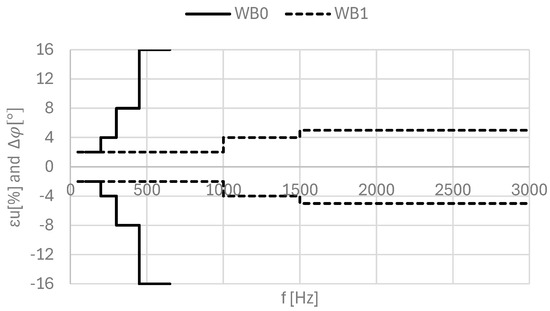
Figure 1.
Graphical comparison of extension levels WB0 and WB1 for accuracy class 0.2.
3. Frequency Response of an Inductive Voltage Transformer
Inductive voltage instrument transformers are one of the most used types of instrument transformers. Inductive voltage transformers use classic inductive linkage for accurate transmission of the measured quantity to the secondary side.
The known possibilities of different designs of instrument transformers are summarized and shown in Figure 2 [17]. This expected performance is corroborated by a multitude of references for conventional, closed-core transformers [1,2,3,4,5,6,7,8,9,10,11].
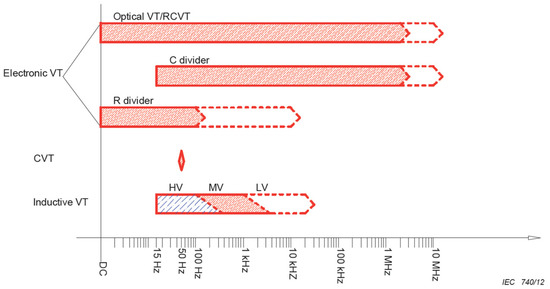
Figure 2.
Voltage transformer technologies frequency range according to present experience—from [16].
However, one of the main goals of this paper is to show how conventional inductive voltage instrument transformers are capable of giving a better response than the one shown in Figure 2.
According to [17], due to uncontrolled interlayer and parasitic capacitances, it is believed that an internal resonance point (or points) will cause significant transmission errors at higher frequencies. The established conclusion is that the mentioned effect is more pronounced as the nominal voltage level increases. This is why it is considered that high-voltage inductive and combined transformers are inherently adequate for accurate measurement up to the 10th harmonic at most, depending on their internal design and voltage level.
Figure 3 further illustrates the above statements [17]. It should be noted that the error levels, both in phase and in voltage magnitude, presented in Figure 3, drastically exceed the prescribed extension levels given in Table 2 and Table 3, by at least two orders of magnitude.
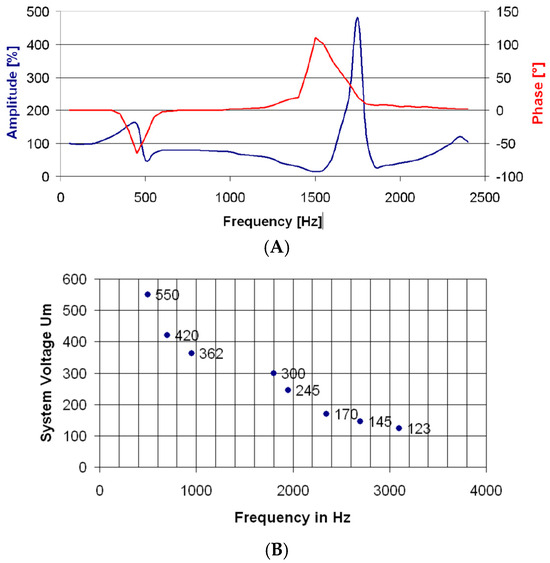
Figure 3.
(A) Frequency response of a typical closed-core inductive voltage instrument transformer for the 420 kV voltage level. (B) The first resonant point of voltage transformers with a closed core depending on the voltage level—from [16].
4. Open-Core Design and Inherent Performance
Conclusions mentioned in the previous chapters are not necessarily applicable to open-core transformers that have a unique insulation system where the critical capacitances are precisely controlled, thus substantially reducing the effect of parasitic capacitance [12]. In addition, the open-core concept also allows optimization of the magnetic circuit, so that the resonant point of the transformer can be controlled [19,20].
An outline of a typical open-core transformer is shown in Figure 4A, while a simplified equivalent circuit is shown in Figure 4B. Figure 5 shows a full model, which is for illustrative purposes shown with a reduced number of nodes. This equivalent model was implemented into an EMTP solver, as explained in the next chapter.

Figure 4.
(A) Layout of a typical open-core voltage transformer. (B) Simplified representation of the main active part.
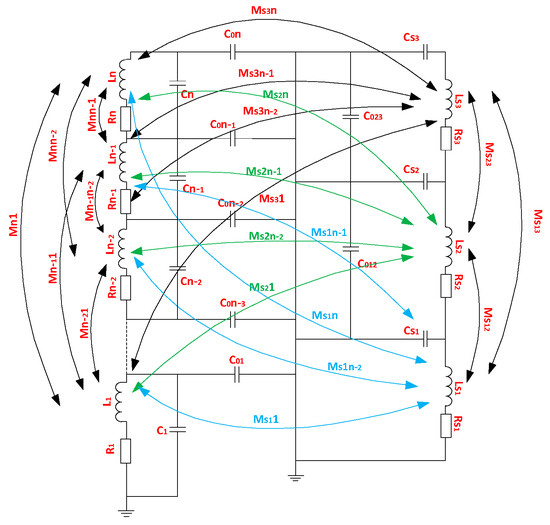
Figure 5.
Complete equivalent diagram of the transformer active part (represented by a reduced number of nodes).
The main feature of an open-core design is the sectioned active part, which serves multiple purposes, both in terms of performance and actual manufacturing [12]. As explained in [12], it is primarily optimized for equalizing dielectric stress across the active part. In addition, it inherently contains a fault-limiting feature, presented in detail in [21]. Given that every section of the active part has its own adjoint cylindrical capacitance that can be geometrically controlled, the effect of parasitic capacitances is greatly reduced, as the dominant capacitance of the adjoint screen is several orders higher. This feature is critical for accuracy performance at frequencies over 1 kHz, as then the unit behaves similarly to a capacitive voltage divider. This is in stark contrast to conventional closed-core transformers, which typically showcase multiple resonant points at values over 1 kHz (approximately) due to their internal capacitances not being controlled precisely.
The inherent benefit of open-core units in terms of accuracy performance at higher frequencies was showcased in [15] and is represented in Figure 6.
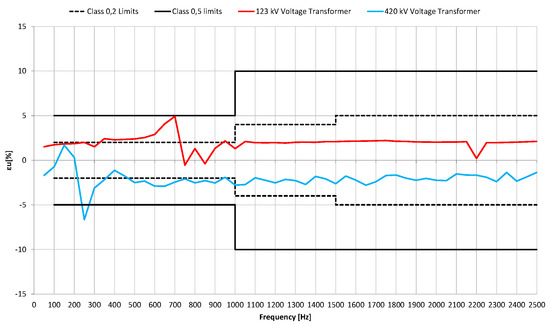
Figure 6.
Measured accuracy performance at higher frequencies for 123 kV and 420 kV inductive voltage instrument transformers compared to limits for 0.2 and 0.5 accuracy classes.
Figure 6 shows the inherent accuracy performance of inductive voltage instrument transformers with an open core for voltage levels of 123 kV and 420 kV obtained through measurement and explained in Section 6. The specified response is compared with the limits of class 0.2 and 0.5 for the extended range WB1.
It is important to note that the transformers shown are not specifically designed for the transmission of higher harmonics. In both cases, it can be seen that the unit performance is, for the better part, conformant to requirements for accuracy class 0.5, while at higher frequencies (i.e., over 1 kHz), it is even within the limits of accuracy class 0.2, which is a consequence of a very finely capacitively graded insulation system [12]. This is especially evident when these results are compared to results presented as state-of-the-art in Figure 3.
However, in both cases, it is evident that, due to the very nature of inductive voltage transformers, the first resonant peaks occur at lower frequencies, typically at 200–700 Hz. These peaks are much less pronounced than what is indicated for closed-core transformers in Figure 3. It was proven in [19] that these resonant peaks can be controlled by optimizing the magnetic circuit of the unit. This illustrates the main motivation behind this paper, which is to establish and calibrate a reliable tool for the calculation of the accuracy performance of inductive voltage and combined transformers at higher frequencies in the design stage. In addition, as explained in this chapter, open-core units inherently possess a higher degree of transfer accuracy than the current “state-of-the-art” suggests. With this in mind, the remainder of this paper will focus on how to adequately model and test that performance.
5. Proposed Model of the Inductive Voltage Transformer
As mentioned in the summary of this paper, the main goal of this paper is to define a relevant transformer model based on a lumped parameter schematic, which considers the actual mutual coupling (both capacitive and inductive) of the transformer windings and insulation system. For that purpose, EMTP software (Electromagnetic Transients Program), version 4.3 [22] was used. It is worth noting that similar models are used in different analyses, primarily aimed at calculating the dielectric performance of the high-voltage insulation system [12,23].
However, this model is specifically upgraded to allow the verification of accuracy at higher frequencies. This entails the modeling of inductive and capacitive coupling between the low-voltage sides, which is not necessary for the calculation of dielectric performance. In addition, the defining characteristic of the proposed model is the required accuracy. While dielectric analyses allow a model accuracy of 10% as adequate, for this purpose, the calculation error needs to be contained below 5% or even lower. The aimed accuracy of the model has to be more stringent due to its application. While the model is not intended to be used for qualification of the accuracy performance, which should always be completed by testing with calibrated equipment in a laboratory with traceable measurement uncertainty, it should give accurate results in terms of where the resonance points occur, what is their magnitude, and what is the overall accuracy of its output. That will make it a very useful tool for analyses and calculations in the design stage of transformer production.
To adequately represent the active part of the inductive voltage transformer, as shown in Figure 5, the necessary input data for the EMTP model are the inductance matrix, which represents mutual coupling between coils of the primary winding and coupling to the secondary winding, and the ohmic resistance matrix, which represents the DC resistance of the respective windings and winding sections It is also necessary to calculate the capacitance between each conductive capacitive screen of the main insulation as well as the parasitic capacitance to ground.
All these elements are represented in Figure 5. Elements marked with C1–Cn represent the interlayer capacitances of the main insulation system. Elements marked with C01–C0n represent the capacitances to ground of each active part section, as explained in [12]. Elements L1–Ln and Mn1–Mnn represent the self and mutual inductances of each active part section within the primary circuit, while Ls1–Lsn and Ms1n–Msnn are the self and mutual inductances of the secondary circuit. The equivalent capacitances of the secondary circuit are marked with Cs01–Cs0n for the ground capacitance and Cs1–Csn for the winding capacitance, respectively. The mutual coupling of the two circuits is modeled through elements Ms11–Ms3n, marked with green, blue, and black arrows in Figure 5. Elements R1–Rn mark the resistances of the sections in the primary winding, while Rs1–Rsn mark the resistances of the secondary winding. The following paragraphs will describe how each of the necessary parameters was obtained. The majority of the procedure was already disclosed in [12]; however, the overall model and its intent were different.
An inductance matrix was obtained through numerical analyses of the transformer using Mentor Graphics MagNet software, version 7.7 [24]. Since the geometry of the transformer is not completely symmetrical and cannot be accurately approximated with an axisymmetric model, a complete 3D model was used, utilizing one-quarter symmetry. The meshed model of the 123 kV unit is shown in Figure 7A. The models for 245 and 420 kV units have the same overall layout, only a larger number of active part segments (nodes).
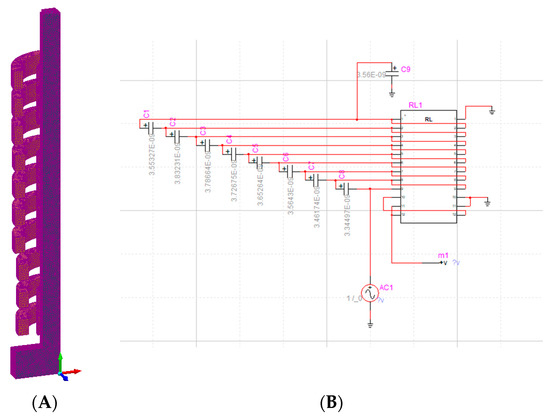
Figure 7.
(A) The meshed model of the inductive 123 kV voltage transformer and (B) the model of the considered 123 kV inductive voltage instrument.
Self and mutual inductances of each coil are calculated according to Expression (1), using the obtained flux values from the numerical calculation described above [12]. This approach can be used for other geometry types as well.
In the above equations, Ψ is the flux linkage of a designated coil, while I is the source current through the i-th coil, always set at a value of 1 A. This way, the resulting flux linkage value corresponds to the appropriate inductance value [12]. The same method was used to determine the mutual coupling between the sections of the primary and secondary circuit (i.e., Lsi and Msij).
The ohmic resistance matrix consists only of diagonal elements, and the value of the resistance for each primary winding coil is calculated analytically according to Expression (2).
In Expression (3), is electrical resistivity (in this case copper), l is the length of the conductor, and S is the cross-sectional area of the conductor. Due to the very small conductor size, typically under 0,5 mm in diameter, any type of frequency dependence of ohmic resistance was neglected [25].
The capacitance matrix consists only of off-diagonal elements (capacitances between main insulation screens), as each screen has a solid capacitance only toward the next screen [12]. These capacitances between each of the conductive capacitive screens are calculated analytically according to Expression (3).
Expression (4) is accurate enough for the calculation of the mutual capacitance of conductive capacitive screens because the main insulation is actually a cylindrical system [12]. In Expression (4), l is the length of the screen, and Ri and Rj are the radii of the i-th and j-th screen, respectively. The capacitance to ground of the voltage transformers is significantly smaller since the screens in the insulation do not have a solid capacitance toward the grounded screen. The magnitude of the ground capacitance was determined numerically using Formula (4) [12].
In the above equation, U is the voltage between two electrodes, and W is the stored electric field energy. The same approach was used to determine the equivalent capacitances of the secondary winding.
Once the calculation of all of the above parameters is completed, they are imported into the EMTP software. For the model of the transformer in EMTP software, a RL coupled device has been chosen. The “RL coupled device” is identical to the “PI device”, the only difference being the capacitance matrix that is set to zero [12]. The electrical equivalent of the three-phase version of the “PI device” was presented in detail in [26]. An exemplary model of the 123 kV inductive voltage instrument transformer is shown in Figure 7B.
The RL coupled device demands the input of an inductance matrix and ohmic resistance matrix, while calculated capacitances need to be connected between pins of the RL device to simulate mutual capacitance between the respective conductive capacitive screens. The capacitance to ground and the voltage source are also connected accordingly, with the voltage probe used to obtain the response of the transformer.
Models of 245 kV and 420 kV transformers are identical in concept and thus excluded from this paper. The only difference is the total number of modeled nodes, which is larger in units of higher voltage levels. Various types of models and combinations of parameters were iterated during the modeling and simulation process, which led to the final model presented in this paper.
The computational time of the model is adequate for everyday use. The calculation of interlayer capacitances and the EMTP calculation are almost instant, while the numerical assessment of ground capacitances and the inductance matrix does require more extensive geometry preparation and computational time, which can vary between 1 and 5 h [12]. For each of the units considered in this paper, the analysis results were obtained in a working day, after the initial models and procedure were established.
One important thing that needs to be emphasized is that the frequency dependence of the parameters is not considered in this model. That is the next step in the development of the model and will be considered in the future. The model does allow a calculation of the transformation ratio, voltage error εu, and phase error Δφ, which are the three necessary parameters that will be considered in the ensuing chapters.
6. Method of Testing the Transmission Characteristics of Instrument Transformers at Higher Frequencies
There are several testing methods that can be used to obtain transmission characteristics of instrument transformers at higher frequencies, as explained in [26,27]. Reference [27] provides very good guidance on the complexity and impracticality of different measurement methods. Precisely for that reason, this paper will focus on the low-voltage method that was used to obtain the results. While this method does have some drawbacks, it is drastically more convenient for application in high-voltage units [26]. The same approach was considered in reference [16].
Initially, the test circuit and equipment presented in [26] were used. However, the drawback of that approach is that the measurement accuracy of the phase error is inadequate for this particular application. For that reason, an updated testing circuit was used, with known tolerances and calibration certificates for each component of the measurement chain. The test circuit is shown in Figure 8A, and the actual test, presented on the basis of the 123 kV unit, is shown in Figure 8B.
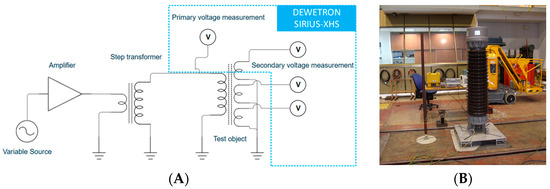
Figure 8.
(A) Test circuit used for measurement of accuracy at higher frequencies and (B) 123 kV inductive voltage transformer during testing.
Variable frequency voltage is supplied on the test object using a function generator (Tektronix AFG3022B, Bristol, UK). The function generator is connected to an amplifier and a step-up transformer to achieve a primary voltage of 200 V and variable frequency between the 1st and 50th harmonic. The measurement device used for both the primary and secondary voltage is DEWESoft SIRIUS-XHS (Serial No. DE00F0249, Trbovlje, Slovenia) with the mathematics integrated function, which calculates the voltage ratio and phase error. The expected accuracy of the measured circuit is 0.03% for the voltage error and 4 min for the phase error, which are both adequate values. The tolerance on the frequency is 0.05%. Before the testing sequence, the measurement system was calibrated.
The method used in this paper is testing the transmission ratio using a low-voltage signal applied to the primary winding of the transformer and measuring the voltage at the secondary winding. While there are other possible test methods that can be utilized, the analysis of their accuracy is a separate topic that will be documented in other work. The presented test setup was used to obtain both the voltage (εu) and phase errors (Δφ) used for assessing the accuracy of the presented calculation model.
However, it should be noted that reference [16] suggests that the limiting aspect of this method may be a low value of high-frequency voltages that can be applied to the primary winding of the instrument transformer. Applying a voltage of higher amplitude may have an effect on the conditions in the transformers and thus the transfer ratio.
Also, due to the low values of voltages on the primary and secondary windings, and the high transformation ratio of the transformer, the secondary voltage can become sensitive to external influences during testing. A significant advantage of this test method lies in its simplicity and in the fact that the measurements can be performed very quickly, which is the reason that this test method is recognized in the IEC standard [7].
7. Result Analysis
As explained in earlier chapters, the model proposed in this paper was verified on three actual inductive voltage transformers, rated at 123 kV, 245 kV, and 420 kV, with the details shown in Table 1. Each of the units was taken from serial production with no alterations or optimizations performed for accuracy performance at higher frequencies. Both simulations and measurements were made in the range from the 1st up to the 50th harmonic, as indicated in Section 2 for bandwidth extension level WB1. It should be noted that, due to clarity, results for winding 1 are presented. The results for other windings with the same geometry (ratio) are practically the same and are, therefore, excluded from this paper.
According to definitions of the voltage error εu and phase error Δφ presented in Section 1, a graphical comparison of the results is shown in Figure 9, Figure 10 and Figure 11. For each of the considered units, three graphs are presented: a comparison of the measured ratio according to the methodology presented in Section 6, a comparison of the calculated ratio according to the methodology presented in Section 5, and a comparison of the measured and calculated voltage error εu and measured and calculated phase error Δφ.
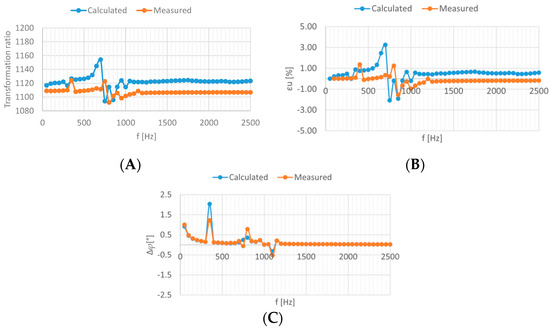
Figure 9.
Results for 123 kV inductive voltage transformer: (A) transformation ratio; (B) voltage error εu; (C) phase error Δφ.
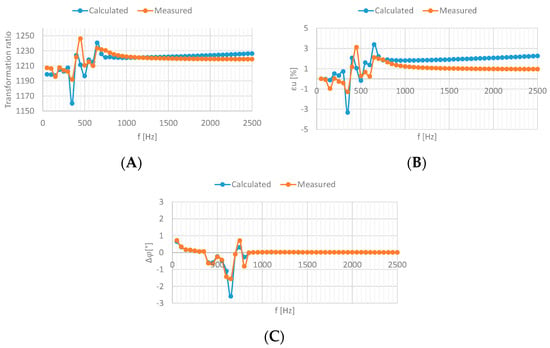
Figure 10.
Results for 245 kV inductive voltage transformer: (A) transformation ratio; (B) voltage error εu; (C) phase error Δφ.
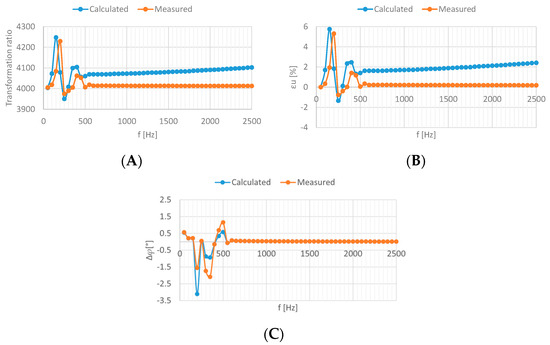
Figure 11.
Results for 420 kV inductive voltage transformer: (A) transformation ratio; (B) voltage error εu; (C) phase error Δφ.
If the above figures are examined purely visually, it can be concluded that there is a bigger error margin present for the transformation ratio and voltage error than the phase error, which is visually more aligned between the calculation and measurement. For that reason, an explicit error assessment is presented in Table 4.

Table 4.
Error analysis between calculation and measurement.
It can be noted that the average errors are actually larger for the phase error than for the voltage error. The main reason for the discrepancy between the visual interpretation and error assessment is the fact that the voltage error is expressed as a percentage, while the phase error is expressed in electrical degrees, which is a fairly large unit for the purpose but is in line with the limits given in Table 3. It is also noticed that the biggest contributor to the error in the phase is the recorded values in resonance points. If we exclude those from the error assessment, the average error between the calculation and measurement reduces under 5%, which is absolutely acceptable for the purpose.
Error analysis shows that the models follow the measurements adequately and represent a good basis for the further development and use of these models. Several aspects of this will be examined further, both on the measurement side and on the modeling side. For measurement, different testing equipment will be used in future research. This will include both measurements with variable frequency and different devices as well as superimposed harmonic content onto the main signal. Due to the high-voltage nature of these transformers, exact measurements at rated voltages are difficult to perform, so reduced levels will be used for the time being.
In terms of modeling, there are two main aspects considered for future research. One is the inclusion of frequency-dependant capacitive and inductive elements, which is expected to increase the accuracy of the model further. The other is a more accurate calculation of capacitances or using measured values. The main reason is that the cylindrical insulation system is sensitive to winding tolerances during manufacturing, which can have an effect on the expected accuracy performance, especially at higher frequencies (above 1 kHz), as seen in Figure 9, Figure 10 and Figure 11. The capacitances are particularly important at these frequencies, as the unit essentially behaves as a capacitive voltage divider.
If the results presented in Figure 9, Figure 10 and Figure 11 are compared to data available from the literature, presented in Figure 3, and discussed in Section 3 and Section 4, it can once again be concluded that the open-core units have an inherently better performance in comparison to their closed-core counterparts. The main reason is not an improvement in coupling between the high-voltage and low-voltage windings; it is, rather, the controlled capacitances of the main insulation system, which make the resonance points much less pronounced, as explained in [12].
The results also confirm the drawbacks of the open-core design, which is an occurrence of the first resonant peak at lower frequencies, typically at 200–700 Hz. By optimizing the magnetic circuit, the resonant frequencies can be altered, as explained in [19].
8. Conclusions
The rapid penetration of renewable energy sources has resulted in a growing need for power quality measurements even at the transmission level, which implies a need for instrument transformers. For the first time, the new edition of the IEC 61869-1 standard defines the accuracy class extension for harmonic measurements for instrument transformers, and not only for the measuring devices.
Traditionally, inductive voltage instrument transformers were not considered suitable for the measurement of higher harmonics. However, this research has shown that certain design variants of inductive voltage transformers, namely, those built around the open-core concept, have a significantly better frequency response from what is considered the industry benchmark in the available literature.
This paper presents a transformer model based on a lumped parameter schematic created in the EMTP software. It is shown that the proposed model yields satisfactory results when compared to the measurement data of actual inductive voltage transformers of different voltage levels. This validates the notion that the models described in this paper are precise enough for sensitivity analyses, performance assessment, and design optimization purposes. The primary intent is that this model is used as a “white-box” model during the design stage of inductive voltage transformers.
As confirmed by results in Section 7, the main advantage of the model is the satisfactory accuracy for establishing the accuracy performance of inductive voltage transformers at higher frequencies. The computational time and the preparation time of the model are manageable for everyday design purposes. The drawback of the model is that it cannot be used without knowing the internals of the considered transformer in detail. For that reason, the model is not suitable for a generic approach.
The presented model is a cornerstone of future work, which will include introducing frequency-dependent lumped parameters into the presented schematic. This is expected to further contribute to the accuracy of the model. Furthermore, the model will be used to determine adequate design optimizations that are necessary to have the considered transformers fully compliant with accuracy requirements at higher frequencies, as specified in the new edition of the IEC 61869-3 standard [7].
Author Contributions
Conceptualization, I.Ž.; Validation, B.J.; Investigation, J.I.; Resources, D.F.; Writing—original draft, J.I.; Writing—review & editing, I.Ž.; Supervision, B.J. and D.F. All authors have read and agreed to the published version of the manuscript.
Funding
This research received no external funding.
Data Availability Statement
The original contributions presented in the study are included in the article, further inquiries can be directed to the corresponding author.
Conflicts of Interest
Authors Josip Ivankić and Igor Žiger were employed by the company Končar—Instrument Transformers Inc. Author Bruno Jurišić was employed by the company Končar—Electrical Engineering Institute Ltd. The remaining authors declare that the research was conducted in the absence of any commercial or financial relationships that could be construed as a potential conflict of interest.
References
- Crotti, G.; Letizia, P.S.; Meyer, J.; Stiegler, R.; Agazar, M.; Istrate, D.; Chen, Y.; Mohns, E.; Cayci, H.; Ayhan, B.; et al. Performance evaluation of instrument transformers in power quality measurements: Activities and results from 19NRM05 IT4PQ project. IET Conf. Proc. 2023, 2023, 3739–3743. [Google Scholar] [CrossRef]
- Crotti, G.; D’Avanzo, G.; Landi, C.; Letizia, P.S.; Luiso, M. Evaluation of Voltage Transformers’ Accuracy in Harmonic and Interharmonic Measurement. IEEE Open J. Instrum. Meas. 2022, 1, 1–10. [Google Scholar] [CrossRef]
- Kaczmarek, M.; Stano, E. Why Should We Test the Wideband Transformation Accuracy of Medium Voltage Inductive Voltage Transformers. Energies 2021, 14, 4432. [Google Scholar] [CrossRef]
- Crotti, G.; D’Avanzo, G.; Landi, C.; Letizia, P.S.; Luiso, M.; Muñoz, F. van den Brom: Instrument Transformers for Power Quality Measurements: A Review of Literature and Standards. In Proceedings of the 2021 IEEE 11th International Workshop on Applied Measurements for Power Systems (AMPS), Virtual, 29 September–1 October 2021. [Google Scholar]
- Crotti, G.; van den Brom, H.E.; Mohns, E.; Tinarelli, R.; Luiso, M.; Styblikova, R.; Agazar, M.; Cayci, H.; Mazza, P.; Meyer, J. Almutairi: Measurement Methods and Procedures for Assessing Accuracy of Instrument Transformers for Power Quality Measurements. In Proceedings of the 2020 Conference on Precision Electromagnetic Measurements (CPEM), Denver, CO, USA, 24–28 August 2020. [Google Scholar]
- IT4PQ Project. Available online: https://www.it4pq.eu/about-project/ (accessed on 20 July 2023).
- IEC 61869-1; Instrument Transformers–Part 1: General Requirements, FDIS Document. International Technical Committee: Geneva, Switzerland, 2022.
- Cataliotti, A.; Cosentino, V.; Crotti, G.; Delle Femine, A.; Di Cara, D.; Gallo, D.; Giordano, D.; Landi, C.; Luiso, M.; Modarres, M. Compensation of nonlinearity of voltage and current instrument transformers. IEEE Trans. Instrum. Meas. 2019, 68, 1322–1332. [Google Scholar] [CrossRef]
- Crotti, G.; Giordano, D.; D’Avanzo, G.; Letizia, P.S.; Luiso, M. A new industry-oriented technique for the wideband characterization of voltage transformers. Measurement 2021, 182, 109674. [Google Scholar] [CrossRef]
- Toscani, S.; Faifer, M.; Ferrero, A.; Laurano, C.; Ottoboni, R.; Zanoni, M. Compensating nonlinearities in voltage transformers for enhanced harmonic measurements: The simplified volterra approach. IEEE Trans. Power Del. 2021, 36, 362–370. [Google Scholar] [CrossRef]
- Crotti, G.; D’Avanzo, G.; Letizia, P.S.; Luiso, M. Measuring harmonics with inductive voltage transformers in presence of subharmonics. IEEE Trans. Instrum. Meas. 2021, 70, 1–13. [Google Scholar] [CrossRef]
- Žiger, I.; Krajtner, D.; Ubrekić, Z. Pushing the boundaries of inductive voltage transformer design. In Proceedings of the 3rd International Colloquium Transformer Research and Asset Management, Split, Croatia, 15–17 October 2014. [Google Scholar]
- Heidary, A.; Niasar, M.G.; Popov, M.; Lekić, A. Transformer Resonance: Reasons, Modeling, Approaches, Solutions. IEEE Access 2023, 11, 58692–58704. [Google Scholar] [CrossRef]
- Stiegler, R.; Meyer, J.; Kilter, J.; Konzelmann, S. Assessment of Voltage Instrument Transformers Accuracy for Harmonic Measurement in Transmission Systems. In Proceedings of the 17th International Conference on Harmonics and Quality of Power (ICHQP), Belo Horizonte, Brasil, 16–19 October 2016. [Google Scholar]
- Krajtner, D.; Ubrekić, Z. Ubrekić: Use of voltage transformers for power quality measurement. In Proceedings of the 10th Savjetovanje hro cigré, Cavtat, Croatia, 6–10 December 2011. [Google Scholar]
- Filipović-Grčić, D.; Filipović-Grčić, B.; Krajtner, D. Frequency response and harmonic distortion testing of inductive voltage transformer used for power quality measurements. In Proceedings of the 4th International Colloquium Transformer Research and Asset Management, Pula, Croatia, 10–12 May 2017. [Google Scholar]
- Instrument Transformers–The Use of Instrument Transformers for Power Quality Measurement–Technical Report: International Electrotechnical Commission, 1st ed.; International Electrotechnical Commission: Geneva, Switzerland, 2012.
- IEC 61000-4-7:2002; Electromagnetic Compatibility (EMC)-Part 4–7: Testing and Measurement Techniques-General Guide on Harmonics and Interharmonics Measurements and Instrumentation, for Power Supply Systems and Equipment Connected Thereto. International Electrotechnical Commission: Geneva, Switzerland, 2002.
- Golub, M. Simultaneous AC and DC Excitation of Open-Core Transformers. Master’s Thesis, University of Zagreb, Faculty of Electrical Engineering and Computing, Zagreb, Croatia, 2019. [Google Scholar]
- Žiger, I.; Krajtner, D.; Filipović-Grčić, D. DC current capability of high voltage apparatus based on the open-core concept. Electr. Power Syst. Res. 2018, 163 Pt B, 647–654. [Google Scholar] [CrossRef]
- Gazivoda, D.; Žiger, I.; Novko, I.; Župan, T. Method for Internal Fault Testing of Instrument Transformers with Sectioned Active Parts. IEEE Access 2021, 9, 143295–143306. [Google Scholar] [CrossRef]
- EMTP User Manual–Version 4.3. Available online: https://emtp.com/documentation/emtp-user-manual (accessed on 20 July 2023).
- Poornima, S.; Sathyanandan, L.; Sugumaran, C.P. Ferroresonance Mitigation in an Inductive Voltage Transformer Using Memristor Emulator. In Proceedings of the 2019 International Conference on High Voltage Engineering and Technology (ICHVET), Hyderabad, India, 7–8 February 2019. [Google Scholar]
- Available online: https://plm.sw.siemens.com/en-US/simcenter/electromagnetics-simulation/magnet/ (accessed on 20 July 2023).
- Trkulja, B.; Drandić, A.; Milardić, V.; Žiger, I. Evaluation of Methodology for Lightning Impulse Voltage Distribution over High-Voltage Windings of Inductive Voltage Transformers. Energies 2021, 14, 16. [Google Scholar] [CrossRef]
- Ivankić, J.; Konta, I.; Žiger, I.; Brezak, D.; Jurišić, B. Jurišić: Accuracy requirements for the transmission of higher harmonics with instrument transformers. In Proceedings of the 16th savjetovanje HRO CIGRE, Šibenik, Croatia, 5−8 December 2023. [Google Scholar]
- Crotti, G.; D’Avanzo, G.; Femine, A.D.; Gallo, D.; Iodice, C.; Landi, C.; Letizia, P.S.; Luiso, M. Fast Frequency Characterization of Inductive Voltage Transformers Using Damped Oscillatory Waves. IEEE Trans. Instrum. Meas. 2024, 73, 1–14. [Google Scholar] [CrossRef]
Disclaimer/Publisher’s Note: The statements, opinions and data contained in all publications are solely those of the individual author(s) and contributor(s) and not of MDPI and/or the editor(s). MDPI and/or the editor(s) disclaim responsibility for any injury to people or property resulting from any ideas, methods, instructions or products referred to in the content. |
© 2025 by the authors. Licensee MDPI, Basel, Switzerland. This article is an open access article distributed under the terms and conditions of the Creative Commons Attribution (CC BY) license (https://creativecommons.org/licenses/by/4.0/).